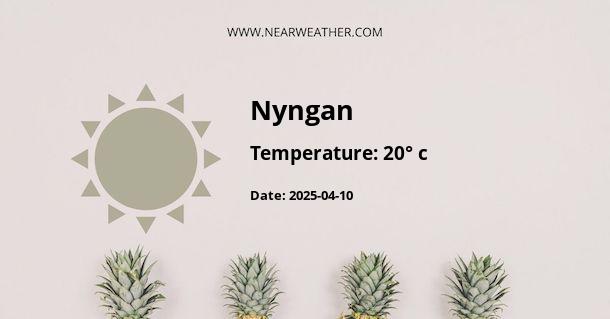Nyngan, Australia: Climate and Weather Year Round
Nyngan is a charming town located in the Bogan Shire of New South Wales, Australia. It is known for its rich agricultural heritage, friendly community, and diverse wildlife. One of the key aspects that make Nyngan unique is its climate and weather patterns, which significantly influence the region's activities, agriculture, and lifestyle. Let's explore the climate of Nyngan and the weather it experiences throughout the year.
Geographical Location
Nyngan is situated in the central-western part of New South Wales, approximately 580 kilometers northwest of Sydney. It lies on the eastern bank of the Bogan River and is surrounded by vast plains and grasslands. The town's proximity to the Great Dividing Range and its position within the Outback region greatly influence its climate.
Climate Classification
Nyngan falls under the semi-arid climate classification (BSh) according to the Köppen climate classification system. This classification indicates that the town experiences hot summers and mild to cool winters. The region is characterized by low annual rainfall and a significant temperature range throughout the year.
Temperature
The climate of Nyngan is marked by distinct seasons, with each season having its own temperature characteristics. The table below provides an overview of the average monthly maximum and minimum temperatures in Nyngan:
| Month | Average Maximum Temperature (°C) | Average Minimum Temperature (°C) |
|---|---|---|
| January | 35.3 | 19.8 |
| February | 33.7 | 18.8 |
| March | 30.7 | 15.8 |
| April | 26.0 | 11.3 |
| May | 21.0 | 7.3 |
| June | 17.2 | 4.1 |
| July | 16.1 | 3.2 |
| August | 18.5 | 4.7 |
| September | 22.2 | 8.1 |
| October | 26.0 | 11.8 |
| November | 30.2 | 15.2 |
| December | 33.5 | 18.4 |
The data above highlights the region's hot summers, with January and February being the hottest months, averaging maximum temperatures of 35.3°C and 33.7°C, respectively. Winters in Nyngan are mild to cool, with June and July experiencing average maximum temperatures of 17.2°C and 16.1°C, respectively. The temperature drop during the winter nights is notable, with the lowest average minimum temperature recorded in July at 3.2°C.
Rainfall
Nyngan receives a relatively low amount of rainfall throughout the year, which is characteristic of its semi-arid climate. The table below presents the average monthly rainfall in Nyngan:
| Month | Average Rainfall (mm) |
|---|---|
| January | 42.3 |
| February | 39.9 |
| March | 33.8 |
| April | 23.1 |
| May | 32.1 |
| June | 26.2 |
| July | 23.7 |
| August | 22.3 |
| September | 24.0 |
| October | 32.5 |
| November | 37.0 |
| December | 36.9 |
The data above shows that the region experiences a slightly higher rainfall during the summer months, with January and February having average rainfall of 42.3mm and 39.9mm, respectively. However, the rainfall remains relatively low throughout the year, with the lowest average monthly rainfall recorded in April at 23.1mm. It is important to note that rainfall patterns in Nyngan can vary significantly from year to year, and occasional droughts may occur, affecting the local agriculture and water resources.
Sunshine Hours
Nyngan enjoys a substantial amount of sunshine throughout the year. The region experiences approximately 3,000 hours of sunshine annually, with an average of around 8 hours per day. The highest number of sunshine hours can be observed during the summer months, while the winter months have slightly fewer sunshine hours.
Extreme Weather Events
Like many regions in Australia, Nyngan is prone to extreme weather events. Severe thunderstorms, including hailstorms and heavy rainfall, can occur during the warmer months, potentially leading to flash flooding. The region is also susceptible to heatwaves during the summer, with temperatures soaring above 40°C. Additionally, dust storms are not uncommon in the area, particularly during periods of dry and windy weather.
Conclusion
Nyngan experiences a semi-arid climate with hot summers and mild to cool winters. The region's temperature ranges from scorching highs in summer to chilly lows in winter. Rainfall is relatively low throughout the year, with occasional variations and the possibility of droughts. Nyngan is blessed with abundant sunshine hours, making it an ideal location for solar energy. However, the town is susceptible to extreme weather events such as thunderstorms, heatwaves, and dust storms. Understanding the climate and weather patterns of Nyngan is essential for residents, farmers, and visitors, allowing them to adapt and prepare for the conditions they may encounter.
A - Nyngan's Latitude is -31.566669 & Longitude is 147.183334.
A - Weather in Nyngan is 20° today.
A - Climate Conditions in Nyngan shows broken clouds today.
A - Humidity in Nyngan is 57% today.
A - Wind speed in Nyngan is 10.44 km/h, flowing at 33° wind direction. today.
